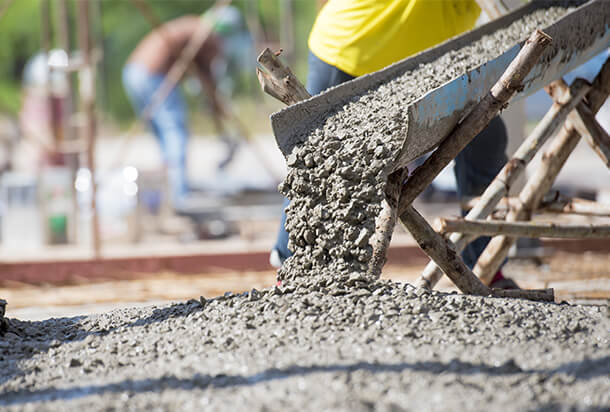พื้นฐานของการเขียนแบบก่อสร้าง เขียนแบบโครงสร้างฐานราก พื้นชั้นต่างๆ โครงหลังคา รูปตัด รูปขยายหน้าตัดพื้น คาน เสา ฐานราก รูปขยายจุดต่อโครงสร้างและการใช้คอมพิวเตอร์เขียนแบบและออกแบบ (Building construction drawing introduction, drawing of foundation structure, floor, roof, cross-section, the detail area, beam, column, foundation, a junction structure plan, the use of computer programs for drawing and design)
ประวัติของซีเมนต์ ประเภทและคุณสมบัติของปูนซีเมนต์ น้ำ มวลรวม วัสดุและสารผสมเพิ่ม การออกแบบส่วนผสมคอนกรีต การควบคุมคุณภาพคอนกรีต การทดสอบคอนกรีตสดและคอนกรีตที่แข็งตัวแล้ว คุณสมบัติทางกลของคอนกรีต การคืบ การล้า และการหดตัวของคอนกรีต ความคงทนของคอนกรีต วัสดุปอซโซลาน คอนกรีตกำลังสูงและคอนกรีตพิเศษ (History of cement, classification and properties of cements, water, aggregates, additives and admixtures, concrete mix design and quality control, testing of fresh and harden concrete, mechanical properties of concrete, creep, fatigue and shrinkage of concrete, durability of concrete, Pozzolanic materials, high strength concrete and special concrete)

การสำรวจทั่วไปทางธรณีวิทยา ที่เกี่ยวข้องกับงานวิศวกรรมโยธา ลักษณะธรณีวิทยาที่เหมาะสมกับที่ตั้งอ่างเก็บน้ำ เขื่อน การเกิดแผ่นดินไหว กับการส่งผลกระทบต่องานโครงสร้างทางวิศวกรรมโยธา โครงสร้างทางธรณีวิทยาที่มีต่อผนังลาดเอียง ความรู้เกี่ยวกับน้ำบาดาล การขุดเจาะน้ำบาดาล อุบัติภัยทางธรรมชาติต่าง ๆ เช่น แผ่นดินทรุด การปฏิบัติการตรวจวินิจฉัยชนิดของแร่และหิน การใช้แผนที่ธรณีวิทยาและการวิเคราะห์ปัญหาทางธรณีวิศวกรรมโดยใช้โปรแกรมคอมพิวเตอร์ (General surveys of geology in relation to the civil engineering application , geology of dam sites and reservoirs, earthquakes and the influence upon civil engineering structural geology affecting slope wall, ground water and water well drilling, natural geologic hazards such as subsidence, practice to classify and identify rock and mineral, use of geologic map, analysis of the engineering geology problem by computer packages.)


Advanced Statistics for Civil Engineering
คำอธิบายรายวิชา
ความจำเป็นของวิธีทางสถิติในงานวิศวกรรมโยธา ทฤษฎีความน่าจะเป็น ตัวแปรสุ่ม แบบจำลองการแจกแจงความน่าจะเป็นในงานวิศวกรรมโยธา การประมาณค่าทางสถิติ และการทดสอบสมมติฐานสำหรับวิศวกรรมโยธา การวิเคราะห์ตัวประกอบในงานวิศวกรรมโยธา การวิเคราะห์ความถดถอยในงานวิศวกรรมโยธา และการประยุกต์ใช้โปรแกรมวิเคราะห์ทางสถิติ
Necessity of statistical methods in civil engineering, probability
theory, random variables, probability distribution models in civil engineering,
statistical estimation and hypothesis testing in civil engineering, factor
analysis in civil engineering, applications of regression analysis in civil
engineering, application of statistical analysis software
Research Methodology in Civil Engineering
คำอธิบายรายวิชา
งานวิจัยขั้นสูงทางด้านวิศวกรรมโยธา ลักษณะเฉพาะของการวิจัยทางวิศวกรรมโยธา การจัดทำโครงร่างการวิจัย การรวบรวมและการค้นคืนข้อมูล เครื่องมือในการทดลองเฉพาะทางวิศวกรรมโยธา การวิเคราะห์ข้อมูล การเรียบเรียงและเขียนบทความทางวิชาการเพื่อเผยแพร่ในวารสารวิชาการระดับนานาชาติ
Advanced research in civil engineering, unique research characteristics of civil engineering, research proposal preparation, data gathering and information retrieval, experiment tools in civil engineering, data analysis, technical report writing for international publication